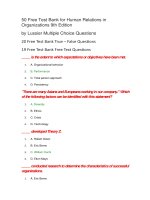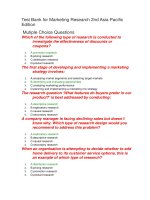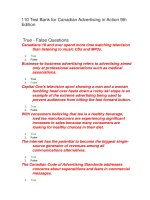Test bank for nursing research in canada 3rd edition by lobiondo wood download
Bạn đang xem bản rút gọn của tài liệu. Xem và tải ngay bản đầy đủ của tài liệu tại đây (143.82 KB, 10 trang )
Test Bank for Nursing Research in Canada 3rd Edition by LoBiondo
Wood
Sample
Chapter 11: Nonexperimental Designs
MULTIPLE CHOICE
1. What is the first question that should be asked in determining whether an
experimental design or a nonexperimental design should be used in a
quantitative study? a. Is there an independent variable?
b. What is the nature of the problem being studied?
c. Will a measurement tool or instrument be needed?
d. Can statistical analysis be applied to the study data?
ANS: B
Feedback
A
Independent variables are used in both experimental and nonexperimental
studies.
B
The nature of the research problem determines whether an experimental or
nonexperimental design should be used.
C
A measurement tool or instrument can be used in both nonexperimental and
experimental designs.
D
Statistical analyses can be used in both experimental and nonexperimental
designs.
DIF: Cognitive Level: Comprehension REF: Page 235
2. When should a descriptive or exploratory design be used?
a. When expanding the results of a qualitative study
b. When direct contact with potential subjects is not possible
c. When little is known about a particular subject or phenomenon
d. When issues of cause and effect in a situation have already been determined
ANS: C
Feedback
A Expanding the results of a qualitative study does not mandate the use of a
descriptive or exploratory design.
B Descriptive designs often involve direct contact with subjects.
C A descriptive or exploratory design is appropriate when little is known about a
research topic.
D Cause and effect are determined by both quasiexperimental and experimental
designs.
DIF: Cognitive Level: Application REF: Page 236
3. Which of the following titles suggests a descriptive study?
a. Characterization of Chemotherapy-Induced Peripheral Neuropathy
b. The Lived Experience of Liver Transplantation Among Older Caucasian Men
c. Effect of Virtual Reality as a Distraction Intervention on Adolescents Undergoing
Chemotherapy
d. Correlation Between Current Income Level and Self-Esteem Among Recently
Widowed Women
ANS: A
Feedback
A The word characterization suggests that the researcher is conducting a
descriptive study on chemotherapy-related neuropathy.
B The phrase lived experience is associated with phenomenological research.
C The phrase effect of is associated with an experimental design.
D The phrase correlation between is associated with correlational level quantitative
research.
DIF: Cognitive Level: Analysis REF: Page 236
4. Which of the following is an advantage of research studies that examine the
association or relationships between variables?
a. Ability to determine a causal relationship
b. Possibility for greater manipulation of the variables
c. Randomization of participants that allows for increased generalizability
d. Potential for application in clinical settings and establishment of a foundation for
future experimental studies.
ANS: D
Feedback
A
Causal relationships are usually determined by experimental and
quasiexperimental designs.
B
Correlational or association-type designs do not involve manipulation of
variables.
C
Randomization can be used in various levels of research and is not reserved
only for associative research.
D
The advantages of correlational studies include their applicability to clinical
settings and the establishment of a foundation for future experimental designs.
DIF: Cognitive Level: Knowledge REF: Page 235
5. Which of the following would be used to assess whether mental health patients
who received
cognitive behavioural therapy via smart phones remain out of hospitals for longer
periods of time.
a. Cross-sectional survey
b. longitudinal, comparative survey
c. Predictive, statistical survey
d. Causative, correlational survey
ANS: B
Feedback
A
A cross-sectional survey would not allow study of hospitalization over
time, since the survey would occur at only one point.
B
A survey that collected data several times from two groups (those with and
without smart phone therapy) would properly assess therapeutic effects. C
Predictive design and statistical survey analysis would not be adaptable to this
research scenario.
D A causative survey would not be used in a correlational study.
DIF: Cognitive Level: Application REF: Pages 235–236
6. What is the purpose of a correlational study of multiple variables?
a. To identify the independent variable
b. To test whether one variable causes another variable
c. To examine relationships between or among variables
d. To distinguish how different one variable is from another variable
ANS: C
Feedback
A The independent variable(s) should be identified by the researcher planning a
study.
B Causation cannot be established by a correlational study.
C A multivariate correlational study examines relationships between or among
variables.
D A correlational study will not help distinguish one variable from another.
DIF: Cognitive Level: Comprehension REF: Page 236 | Page 238
7. Which of the following factors or situations in a study using a correlational design
should cause you to question the validity of the study?
a. The study did not have a nontreatment control group.
b. The researchers concluded that a causal relationship existed between the
variables.
c. The researchers suggested that their findings had practical application in a
clinical setting.
d. The researchers used pre-existing instruments to measure the variables instead
of developing specific instruments for the
study.
ANS: B
Feedback
A
Control groups are not used in correlational studies, which have a
nonexperimental design.
B
The design of correlational studies does not permit the generation of causal
inferences.
C
Practical applications of the study findings in a clinical setting may be
appropriate for various levels of research.
D
Use of validated, reliable pre-existing instruments is considered entirely
appropriate in research.
DIF: Cognitive Level: Analysis REF: Pages 238–239 8.
What is the purpose of developmental study designs?
a. Comparing the results of qualitative studies of a particular phenomenon with the
results of quantitative studies of the same phenomenon
b. Re-analysis of existing data for a secondary purpose not stated in the original
research
c. Exploration of the changing nature of relationships among variables over time
d. Development or refinement of a tool or instrument
ANS: C
Feedback
A Comparison of studies would be a component of literature review.
B This is the definition of secondary analysis.
C Developmental design permits the changing nature of relationships among
variables over time.
D Development or refinement of a tool or instrument is the purpose of
methodological research.
DIF: Cognitive Level: Knowledge REF: Page 240
9. Which of the following statements about cross-sectional studies is true?
a. More than one group can be compared.
b. Only descriptive data can be measured.
c. Data are collected retrospectively, rather than prospectively.
d. Data collection and data analysis can occur simultaneously.
ANS: A
Feedback
A The cross-sectional design allows multiple group comparison.
B Cross-sectional analysis is not reserved for only descriptive data.
C In a cross-sectional study, data are collected across groups at one point in time.
D Data analysis would follow data collection in cross-sectional studies.
DIF: Cognitive Level: Comprehension REF: Page 240
10. Which of the following study titles suggests a cross-sectional design?
a. Effect of Prenatal Parenting Classes on Maternal–Infant Bonding in the Early
Postpartum Period
b. Change in Self-Esteem Over Time Among Women Participating in a Weight Loss
Support Group
c. Relationship Between Self-Esteem and Successful Breastfeeding at 1 Month and 6
Months After Delivery
d. Women’s Appraisal of the Diagnosis Within the First 48 Hours After Initial Breast
Cancer Diagnosis
ANS: D
Feedback
A Parenting classes during the early postpartum period would not be suitable for a
cross-sectional study.
B A cross-sectional design would not be used to analyze change in self-esteem over
time.
C Data collection at two separate points is not done in a cross-sectional design.
D The study’s title suggests a design involving data collection at one point in time.
DIF: Cognitive Level: Analysis REF: Pages 239–240
11. Which of the following is an advantage of studies that use a longitudinal or
prospective design?
a. The data obtained are focused and deep.
b. The study overall is more manageable for the researcher.
c. The issue of maturation as a threat to internal validity is avoided in this design.
d. This design does not require the use of tools or instrumentation.
ANS: A
Feedback
A Longitudinal or prospective designs are associated with more in-depth, focused
data collection.
B A longitudinal design can be more difficult for the researcher given the length of
time involved.
C Maturation is a threat to internal validity in longitudinal design.
D The longitudinal design often requires use of measurement tools or instruments.
DIF: Cognitive Level: Comprehension REF: Page 240
12. Which of the following titles is most suggestive of a longitudinal study?
a. Effect of Prenatal Parenting Classes on Maternal–Infant Bonding in the Early
Postpartum Period
b. Change in Self-Esteem Over Time Among Women Participating in a Weight Loss
Support Group
c. Relationship Between Self-Esteem and Successful Breastfeeding at 1 Month After
Birth
d. Women’s Appraisal of the Diagnosis Within the First 48 Hours After Initial
Diagnosis of Breast Cancer
ANS: B
Feedback
A
A study of the early postpartum period would have a design of short
duration, not a longitudinal design.
B
A longitudinal study monitors research subjects over a long period, as in
observing “a change in self-esteem over time.”
C
Studying relationships among variables at one point in time is not
characteristic of a longitudinal design.
D
A study of the appraisal of breast cancer diagnosis in the first 2 days after
diagnosis does not have a longitudinal design.
DIF: Cognitive Level: Analysis REF: Page 240
13. What is the major characteristic of a retrospective, or ex post facto, study?
a. Obtaining informed consent is not an important issue in a retrospective study.
b. Maximal opportunity to manipulate the independent variable exists in a
retrospective study.
c. In a retrospective study, the dependent variable is measured multiple times to
examine the effect of maturation.
d. The dependent variable has already been affected by the independent variable in
a retrospective
study.
ANS: D
Feedback
A
Informed consent may be necessary in a retrospective study for certain
research topics.
B
A retrospective study does not involve the manipulation of variables. C
Effect on the dependent variable has occurred already, so maturation is not an
issue in a retrospective study.
D In an ex post facto study, the dependent variable has already been affected.
DIF: Cognitive Level: Comprehension REF: Page 241
14. How is an ex post facto design more advantageous than a correlational design?
a. This design is easier to carry out.
b. The independent variable can be manipulated in this design.
c. A greater degree of control is possible with this design.
d. This design offers increased flexibility when the relationships among the
variables in the study are complex.
ANS: C
Feedback
A An ex post facto design is not an inherently easier design than a correlational
design.
B No variable is manipulated in an ex post facto design.
C A retrospective or ex post facto study offers a higher level of control than does a
correlational study.
D Complex interrelationships usually decrease flexibility in a study.
DIF: Cognitive Level: Comprehension REF: Page 241
15. Which of the following types of design would be appropriate to forecast the
effects of
psychoeducational interventions on psychological adaptation of women diagnosed
with breast cancer?
a. Correlational
b. Prediction
c. Descriptive
d. Ex post facto
ANS: B
Feedback
A A correlational design cannot determine causation or treatment effects. B A
prediction design would be the most appropriate design to forecast the effects of
an intervention on a particular dependent variable.
C A descriptive design is used to describe characteristics of variables and does not
allow testing of treatment effects.
D An ex post facto study does not permit manipulation of variables.
DIF: Cognitive Level: Application REF: Pages 243–244
16. What study type is indicated by data collection at only one point in time? a.
Cross-sectional
b. Retrospective
c. Longitudinal
d. Prospective ANS: A
Feedback
A The cross-sectional design is associated with data collection at one point in time.
B The retrospective design involves analysis of data that has already been collected.
C The longitudinal design involves data collection over a period of time.
D The prospective design involves data collection over time, well into the future.
DIF: Cognitive Level: Knowledge REF: Pages 239–240
17. In a study of psychosocial adjustment to breast cancer, data collection
instruments were sent
to the same sample of women at six different times during their first year of living
with breast cancer. What type of study design does this exemplify? a. Crosssectional
b. Retrospective
c. Longitudinal
d. Correlational
ANS: C
Feedback
A The cross-sectional design involves data collection at one point in time.
B In the retrospective design, relationships about past events are examined in order
to analyze their possible effects on current variables.
C The longitudinal design involves data collection from the same group(s) at
different points in time.
D The correlational design examines relationships among variables usually at one
point in time.
DIF: Cognitive Level: Application REF: Page 240
18. Which of the following threats to internal validity is more likely to occur with a
longitudinal design?
a. Instrumentation effects
b. Mortality effects
c. History effects
d. Selection bias
ANS: B
Feedback
A Instrumentation effects or testing effects can occur in many types of research
design, and are not necessarily more likely in longitudinal design.
B A major disadvantage of longitudinal design is loss of research subjects.
C History effects can occur in any kind of research design.
D Selection bias occurs because of problems in sampling processes rather than in
the design.
DIF: Cognitive Level: Comprehension REF: Page 240
19. In which study design do participants serve as their own controls, allowing early
trends in the data to emerge?
a. Cross-sectional
b. Ex post facto
c. Retrospective
d. Longitudinal
ANS: D
Feedback
A
The cross-sectional design does not allow for intraparticipant comparisons
because data are collected at one point in time.
B
In ex post facto research, events have already occurred; intraparticipant
comparison therefore does not occur in this type of study.
C
Retrospective studies are similar to ex post facto research, in which events
have already occurred; intraparticipant comparison therefore does not occur in this
type of study.
D
In longitudinal studies, subjects serve as their own controls, which allows for
trends in the data to emerge.
DIF: Cognitive Level: Comprehension REF: Page 241
20. What type of research focuses on the theory and development of measurement
instruments?
a. Meta-analysis
b. Psychometrics
c. Methodology
d. Data management
ANS: B
Feedback
A Meta-analysis quantitatively summarizes the results of many research studies. B
Psychometrics deals with the theory and development of measurement
instruments.
C Methodology is the section of a research report that describes the design, sample,
setting, instrumentation, and procedures.
D Data management is a generic term for organizing and analyzing collected data.
DIF: Cognitive Level: Knowledge REF: Page 244
21. If no hypothesis is present in a study, does this indicate a weakness in the study?
Why, or why not?
a. This is not a weakness, as the study can be descriptive.
b. This is not a weakness, if the study is quasiexperimental.
c. This is a weakness, as the study is descriptive.
d. This is not a weakness, as the study can be quasiexperimental.
ANS: A
Feedback
A Descriptive nonexperimental designs use research questions, not hypotheses. B
The study is not quasiexperimental, but if it were, a hypothesis would be
necessary.
C Descriptive nonexperimental designs use research questions, not hypotheses. D
The study is not quasiexperimental, but if it were, a hypothesis would indeed be
necessary.
DIF: Cognitive Level: Analysis REF: Page 235









